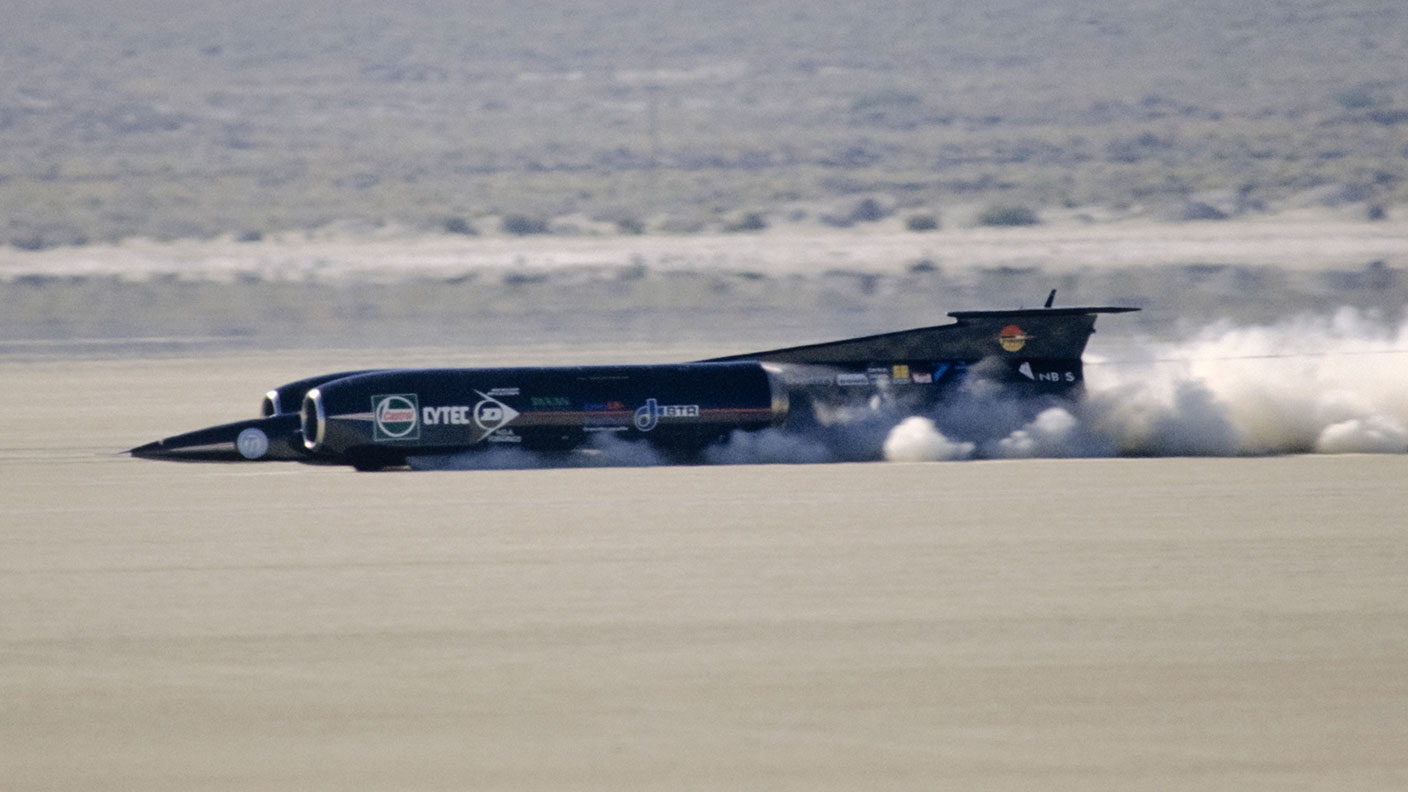15 October 1997: Britain’s Thrust supersonic car breaks the sound barrier
On this day in 1997, the Thrust supersonic car propelled RAF pilot Andy Green through the sound barrier to set a new World Land Speed Record.


If you're after a car with environmental credentials, the Thrust supersonic car (SSC) isn't for you. Burning around 18 litres of fuel a second, it makes a Volkswagen look like a Prius. What it is, though, is fast. So fast in fact, that it's even faster than sound.
On 15 October 1997, in the Black Rock Desert in Nevada, the British-designed and built Thrust SSC smashed through the sound barrier, reaching a top speed of 763mph to set a new (and as yet unbroken) World Land Speed Record. The record-breaking attempt came 50 years and a day since Chuck Yeager became the first person to break the sound barrier in his Bell X-1 rocket plane in 1947.
But of course, unlike the Bell X-1, the Thrust SCC kept its wheels on the 14-mile track. Two hulking great Rolls Royce Spey turbofan engines straight off a Phantom jet fighter shouldered a slender 16.5-metre long dart-like body, producing over 110,000 BHP of power. That, for those who have ever wondered, is the equivalent of a thousand Ford Escorts, the team's website tells us.
MoneyWeek
Subscribe to MoneyWeek today and get your first six magazine issues absolutely FREE

Sign up to Money Morning
Don't miss the latest investment and personal finances news, market analysis, plus money-saving tips with our free twice-daily newsletter
Don't miss the latest investment and personal finances news, market analysis, plus money-saving tips with our free twice-daily newsletter
Who'd be mad enough to put himself at the epicentre of all this brute power? Well, a surprising number of people, actually. Thirty-two applications to drive the supersonic car were received, but only one man emerged from the gruelling six-month selection process: RAF wing commander Andy Green.
In true British fashion, the project headed by Richard Noble had an extremely modest budget, compared to the £25m the McLaren F1 team was prepared to chuck at its supersonic attempt. The Thrust SSC programme got underway with just £40,000 from sponsor Castrol.
Convincing big-name sponsors to take part proved to be a headache, while the insurance companies only gave the Thrust SSC the same rates as for a domestic car. However, in the end, over £500,000 was raised from sponsors and donations, and the Thrust SSC was able to make its record-breaking run.
Yet the engines from the Phantom were already pretty obsolete by the time they propelled Andy Green through the sound barrier. What would happen if you used the modern engines from a Eurofighter Typhoon and a next generation space rocket? Andy Green is hoping to find out.
Get the latest financial news, insights and expert analysis from our award-winning MoneyWeek team, to help you understand what really matters when it comes to your finances.

-
 ‘Why I have ditched my Help to Buy ISA for cash savings and the stock market’
‘Why I have ditched my Help to Buy ISA for cash savings and the stock market’Without the 25% bonus, my Help to Buy ISA is effectively redundant, says MoneyWeek writer Sam Walker.
-
 Is your inheritance tax allowance cut if you sell to downsize or sell your home to pay for care?
Is your inheritance tax allowance cut if you sell to downsize or sell your home to pay for care?Downsizing relief is a little-known benefit that could save your loved ones tens of thousands of pounds in inheritance tax after you’ve died.
-
 31 August 1957: the Federation of Malaya declares independence from the UK
31 August 1957: the Federation of Malaya declares independence from the UKFeatures On this day in 1957, after ten years of preparation, the Federation of Malaya became an independent nation.
-
 13 April 1960: the first satellite navigation system is launched
13 April 1960: the first satellite navigation system is launchedFeatures On this day in 1960, Nasa sent the Transit 1B satellite into orbit to provide positioning for the US Navy’s fleet of Polaris ballistic missile submarines.
-
 9 April 1838: National Gallery opens in Trafalgar Square
9 April 1838: National Gallery opens in Trafalgar SquareFeatures On this day in 1838, William Wilkins’ new National Gallery building in Trafalgar Square opened to the public.
-
3 March 1962: British Antarctic Territory is created
Features On this day in 1962, Britain formed the British Antarctic Territory administered from the Falkland Islands.
-
10 March 2000: the dotcom bubble peaks
Features Tech mania fanned by the dawning of the internet age inflated the dotcom bubble to maximum extent, on this day in 2000.
-
9 March 1776: Adam Smith publishes 'The Wealth of Nations'
Features On this day in 1776, Adam Smith, the “father of modern economics”, published his hugely influential book The Wealth of Nations.
-
 8 March 1817: the New York Stock Exchange is formed
8 March 1817: the New York Stock Exchange is formedFeatures On this day in 1817, a group of brokers moved out of a New York coffee house to form what would become the biggest stock exchange in the world.
-
7 March 1969: Queen Elizabeth II officially opens the Victoria Line
Features On this day in 1969, Queen Elizabeth II took only her second trip on the tube to officially open the underground’s newest line – the Victoria Line.